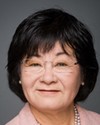Merci.
I'm very happy to have the opportunity to report to the committee on the progress we've made and the difference we've made in the lives of women and girls in Afghanistan. As I said in my presentation, one of the key successes is enabling them access to formal education, where they represent two-thirds of the children attending schools. The education and literacy has improved. There's mobility now. As I said, I was in Afghanistan, and you recognize the fact that you see Afghan women, young women and girls, going to school, in the streets, going shopping, walking down the streets, and then you recognize that this is a significant change in the lives of those women.
The other part I can report on is the improvement of the health care they're receiving. In fact, we have seen a four times increase in the access of women to childbirth attendants. Consequently, with improved medical care and access to medical care, we've been able to reduce the infant mortality by 22%.
The Afghan women, I would suggest, are like all women around the world. They're very entrepreneurial, very industrious, etc. We have contributed $56 million to date to the microfinancing facilities, the MISFA facility. The majority of people accessing that facility, as I say, are women. They are now earning an income for their families. They are establishing businesses. On top of that they're repaying those loans at a 90% rate.
We are also supporting their agricultural efforts with our programs that support livelihood--livestock, seeds, and fertilizer. We see improvements there. Many of the women, of course, are the caregivers in their families, so that they're able to not only participate on an increased level but actually to contribute significantly.
One of the things I'd like to speak to is to recognize that when they have the opportunity, they participate in elections. They participate as voters. To me, that shows they are concerned about their futures, when 43% of the 6.5 million Afghans who voted in the last election were women. They had been denied that previously under the Taliban. Not only that, but 25% are parliamentarians right now. As I said, that's a very successful indication.
The women I've met and the women I've seen are very active. They're learning in some very small projects, very simple embroidery projects. We all shared an opportunity to look at the outcome of the silk scarves that they're making. When you go there, you'll see how entrepreneurial they are.
I think one of the things is to basically understand that there's a recognition of the basic rights of women, their basic human rights--protection against violence, ability to have free mobility, access to education, access to democratic process, access to literacy, access to facilities that are taking better care of their health and consequently the health of their families as well. There's a saying that if you want to ensure that the people are educated, you educate the women, and the women will ensure that everyone gets educated. Of course, the same goes for health care. The same also goes for respecting basic rights. I think we've made a significant difference, along with our partners.
I will point out that we're planning to have 35 CIDA staff in Afghanistan, but we're working along with over 1,300 other development workers through our partnerships, NGOs, and multilateral partners.







